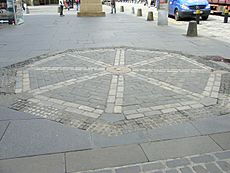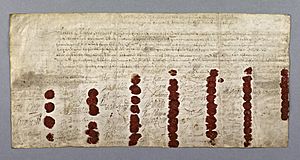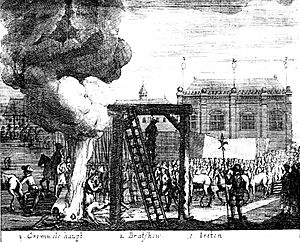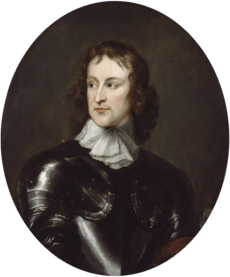List of regicides of Charles I facts for kids
After the trial of King Charles I in January 1649, 59 judges signed his death warrant. These people, along with others involved, faced punishment when the monarchy returned in 1660. This event is known as the Restoration. Charles II became king. King Charles I's trial and execution happened after the second English Civil War. In this war, his supporters (called "Cavaliers") fought against Parliament's supporters (called "Roundheads"), led by Oliver Cromwell.
When King Charles II returned, Parliament passed a law called the Indemnity and Oblivion Act in 1660. This law offered forgiveness for most crimes committed during the Civil War. However, 104 people involved in the King's trial and execution were not forgiven. Twenty-four of them had already died, including Cromwell. Several others were executed, and 19 were sent to prison for life. Many lost their property and could not hold public jobs again. Twenty-one people fled England, mostly to the Netherlands or Switzerland. Three went to New England.
There is no exact list of who counts as a "regicide." The law itself did not use this word. "Regicide" has never been a specific crime in English law. Historians have different ideas about who should be called a regicide. Some only include those who signed the death warrant. Others include people who helped with the trial and punishment.
Contents
Understanding the English Civil War
Why did the English Civil War happen?
The English Civil War was a series of fights and political struggles. It took place between 1642 and 1651. The main reason for the war was a disagreement over political power. It was a fight between Parliament's supporters and King Charles I's supporters.
The war had three main parts. In the first two parts (1642–1646 and 1648–1649), King Charles I's side fought against Parliament's side. The third part (1649–1651) involved fighting between Charles I's son, Charles II, and Parliament. Parliament won the war at the Battle of Worcester in 1651.
The King's trial and execution
After the first part of the war, the Scottish army held King Charles I. They then gave him to Parliament's forces. In January 1649, a trial was set up with 135 judges. Some judges refused to take part. Many were named without their permission. Forty-seven of them did not show up for the trial.
At the end of the four-day trial, 67 judges agreed that King Charles I had "traitorously and maliciously levied war against the present Parliament." Fifty-seven of these judges signed the death warrant. Two more added their names later. The next day, on January 30, King Charles I was beheaded. This happened outside the Banqueting House in Whitehall. Charles II then went into exile. The English monarchy was replaced by the Commonwealth of England (1649–1653). Then came the Protectorate (1653–1659) under Oliver Cromwell's rule.

The return of the monarchy
Cromwell died in 1658, leading to a power struggle. General George Monck helped bring order back. He had fought for the King before joining Cromwell. He arranged for new elections in early 1660. Monck talked with Charles II, who then made the Declaration of Breda. This declaration offered peace and forgiveness. Parliament invited Charles to return.
Charles arrived in Dover on May 25, 1660. He reached London on May 29, his 30th birthday. This marked the Restoration of the monarchy.
Punishment for those involved
The Indemnity and Oblivion Act
In 1660, Parliament passed the Indemnity and Oblivion Act. This law forgave many who had supported Parliament during the war. However, 104 people were specifically excluded from this pardon. Forty-nine of these people, plus the two unknown executioners, faced serious charges. King Charles II might have wanted fewer people punished. But Parliament took a tougher stance.
Twenty-four of those listed for punishment had already died. This included Cromwell, John Bradshaw (the main judge), and Henry Ireton. In 1660, six judges and four others were found guilty and executed. In 1662, three more were executed. Some were pardoned, while 19 others were imprisoned for life. Most had their property taken away. Many were also banned from holding public jobs or titles in the future.
Twenty-one of those in danger fled Britain. Most went to the Netherlands or Switzerland. Some were caught and brought back to England. Others were killed by Royalist supporters. Three, John Dixwell, Edward Whalley, and William Goffe, escaped to New England. They were never caught, even though people searched for them.
What is a "regicide"?
There is no clear definition of who counts as a "regicide." The Indemnity and Oblivion Act did not use this word. Historians have different ideas about who should be included. "Regicide" was seen as a sin, but it was not a specific crime in English law.
Scotland also had its own Act of Indemnity and Oblivion. It was similar to the English one. However, more people were excluded from the pardon in Scotland. Most of these exclusions were about money. Only four men were executed in Scotland, all for treason, not specifically for regicide. The Marquess of Argyll was the most famous. He was found guilty of working with Cromwell's government. He was executed in 1661.
People who signed the death warrant
Here are some of the commissioners who signed King Charles I's death warrant. They are listed in the order they signed.
| Order |
Name | At the Restoration | Notes |
|---|---|---|---|
| 1 | John Bradshaw, President of the Court | Dead | His body was dug up and executed after his death. |
| 3 | Oliver Cromwell | Dead | His body was dug up and executed after his death. |
| 4 | Edward Whalley | Alive | Fled to New Haven Colony with his son-in-law William Goffe. He was alive but sick in 1674. He died around 1675. |
| 6 | John Okey | Alive | Fled to Germany. He was arrested and executed in April 1662. |
| 9 | Henry Ireton | Dead | His body was dug up and executed after his death. |
| 11 | Sir Hardress Waller | Alive | Fled to France, then returned. He was found guilty and sentenced to life in prison. He died in prison in 1666. |
| 14 | William Goffe | Alive | Fled to New Haven Colony with his father-in-law Edward Whalley. He died in 1680. |
| 17 | Thomas Harrison | Alive | He was the first to be found guilty and was executed in October 1660. |
| 30 | Edmund Ludlow | Alive | Escaped to Switzerland and died in 1692. |
| 31 | Henry Marten | Alive | Found guilty and sentenced to life in prison. He died in Chepstow Castle in 1680. |
| 34 | Sir Richard Ingoldsby | Alive | He was pardoned and died in 1685. |
| 38 | John Dixwell | Alive | Fled to New Haven Colony and died in 1689 under a different name. |
| 42 | John Jones Maesygarnedd | Alive | Tried, found guilty, and executed in October 1660. |
| 57 | Thomas Scot | Alive | Fled to Brussels, then returned. He was found guilty and executed in October 1660. |
| 59 | Miles Corbet | Alive | Fled to the Netherlands. He was arrested, brought back, and executed in April 1662. |
Commissioners who did not sign
Some judges were part of the trial but did not sign the death warrant. Here are a few of them:
| Name | At the Restoration | Notes |
|---|---|---|
| Sir James Harington, 3rd Baronet | Alive | Escaped and died in exile in Europe in 1680. |
| Edmund Harvey | Alive | Tried in October 1660 and sentenced to life in prison. He died in prison in 1673. |
| Cornelius Holland | Alive | Fled to the Netherlands and then Switzerland. He probably died in 1671. |
| Sir John Lisle | Alive | Escaped to Switzerland but was killed in 1664. |
| Sir Henry Mildmay | Alive | Tried, lost his knighthood, and sentenced to life in prison. He died in 1664 while in exile. |
| William Mounson, 1st Viscount Monson | Alive | Tried, lost his titles and property, and imprisoned for life. He died in prison in 1673. |
Other people involved
Some other people were also considered "regicides" because of their roles in the King's trial or execution.
| Name | Role | At the Restoration | Notes |
|---|---|---|---|
| Daniel Axtell | Officer of the Guard | Alive | Tried, found guilty, and executed in October 1660. |
| Andrew Broughton | Clerk of the Court | Alive | Escaped to Switzerland in 1663. Died in 1687. |
| John Cook | Solicitor-General | Alive | Tried, found guilty, and executed in October 1660. |
| Francis Hacker | Officer of the Guard | Alive | Tried, found guilty, and executed in October 1660. |
| Hugh Peter | Preacher | Alive | A radical preacher. He was tried and found guilty of encouraging the King's execution. He was executed in October 1660. |
| Anonymous | Headsman and assistant | Unknown | These two people were disguised during the execution. They were also listed for punishment. |
Others found guilty of treason
Some people were not directly involved in the King's trial but were still found guilty of treason.
| Name | At the Restoration | Notes |
|---|---|---|
| John Lambert | Alive | He was not in London for the King's trial. He was found guilty of treason and stayed in prison for the rest of his life. He died in 1683 or 1684. |
| Sir Henry Vane the Younger | Alive | He was not pardoned. He was tried for treason, found guilty, and executed in June 1662. |

In Scotland, under their own Act of Indemnity and Oblivion, most people were pardoned. However, a few members of the old government were tried and found guilty of treason.
| Name | Fate | Notes |
|---|---|---|
| Archibald Campbell | Executed 27 May 1661. | He was found guilty of working with Cromwell's government. He was sentenced to death. |
| James Guthrie | Executed 1 June 1661. | He was tried for treason and found guilty. He was executed. |
| Captain William Govan | Executed 1 June 1661. | He was executed after James Guthrie. |
| Archibald Johnston, Lord Warriston | Executed 22 July 1663 | He fled to Europe but was found and brought back. He was executed. |





